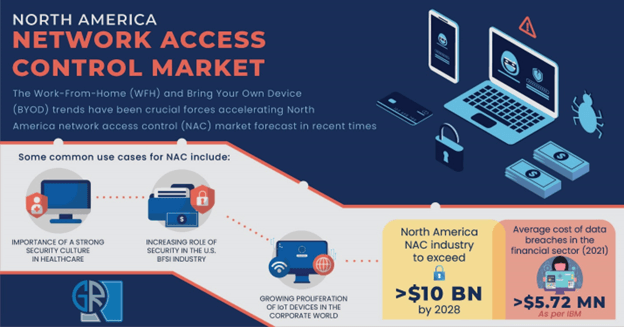The Work-From-Home (WFH) and Bring Your Own Device (BYOD) trends have been crucial forces accelerating North America network access control (NAC) market forecast in recent times. NAC solutions have evolved into a valuable tool for enhancing network security, segmenting guest traffic, and simplifying the provisioning of devices such as VoIP phones, among other things. The COVID-19 pandemic has, in a way, shortened physical borders through increased internet connectivity.
As these diverse systems become more reliant on one another for optimal performance, the risk of enormous data, asset, and reputational harm is greater than ever. Integrating necessary network access control technologies into industries dealing with highly crucial data, such as the IT and telecom, BFSI, healthcare and government organizations has become an imperative need in today’s time.
It is estimated that North America network access control industry size could exceed $10 billion by 2028. Some common use cases for NAC include:

Importance of a strong security culture in healthcare
With cyberthreats becoming more sophisticated, healthcare organizations are actively strengthening their incident response. The top ten data breaches in the first half of 2020 exposed approximately 3.2 million records, with eight of the top ten breaches occurring at medical or healthcare institutions.
As more healthcare businesses shift sensitive data to new networks, due to remote work and growing usage of mobile devices, cybersecurity becomes even more critical. With the implementation of NAC systems, healthcare organizations across the globe are able to safeguard data systems by alerting IT teams of an unidentified person access. They can also automate onboarding services, protect medical devices, and identify medical devices throughout the organization.
Increasing role of security in the U.S. BFSI industry
Cybersecurity in the BFSI industry is one of the most concerning issues nowadays. As per IBM, in 2021, the average cost of data breaches in the financial sector was over $5.72 million, only second to the healthcare industry.
The Federal Reserve Bank of New York stated in a study issued in January 2020 that the danger of cyberattacks is considerable, due to the interconnected nature of the financial sector. According to the study, a cyber assault on any of the five most active U.S. banks could disrupt 38% of the network.
The United States is home to some of the leading banks, including Citigroup Inc (C.N), JPMorgan Chase & Co (JPM.N), Bank of America Corp (BAC.N), Morgan Stanley, and Goldman Sachs Group Inc (GS.N). Experts also warn that US banks are especially vulnerable to state-sponsored cyberattacks from nations such as China, Russia, and North Korea.
Growing proliferation of IoT devices in the corporate world
The COVID-19 pandemic has significantly increased the adoption of connected devices across various end-user sectors, due to their easy-to-use features. However, as per a study published in the CSO Magazine, only 10% of IT managers reported being fully aware of the IoT devices on their networks.
An alarming 64% responded that they either had no level of confidence or very little. Such a situation can be quite risky and create leeway for cyberattacks. With several companies deploying a variety of IoT device types throughout their networks at a healthy pace, industry leaders such as Cisco and Fortinet have introduced next generation NAC solutions to the market that can accommodate several IoT devices.
A rising number of BYOD devices, increasing employee mobility, and the need to support hybrid work environments have impacted the demand for stronger network access control systems. Constant innovations by established manufacturers such as CommScope, Inc., Extreme Networks Inc., Hewlett Packard Enterprise, IS Decisions, Juniper Networks Inc., OPSWAT, Inc., Pulse Secure, LLC., and SolarWinds Worldwide, LLC will transform North America network access control industry trends over the next few years. The adoption of managed NAC services will gain prominence, owing to several cost and operational benefits.


